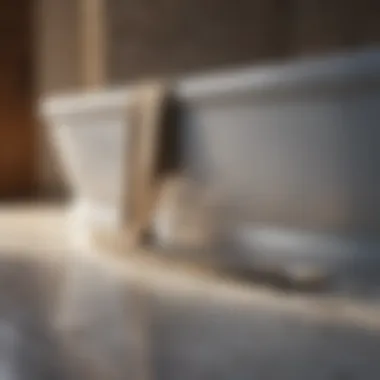Enhance Safety with Anti Slip Strips for Bathtubs


Intro
Ensuring safety in the bathroom, particularly around the bathtub, is a priority for many homeowners. One effective solution to combat the risk of slipping is the use of anti slip strips. These strips provide a straightforward yet powerful defense against falls. As more people emphasize home safety, understanding the various options available is crucial.
Anti slip strips come in a variety of styles and materials, making them both functional and appealing. Their integration into bathroom design can elevate aesthetics while also ensuring peace of mind.
This guide provides an in-depth look into anti slip strips for bathtubs. It will cover current trends, installation methods, maintenance tips, and the broader impact these strips can have on safety and design.
Understanding the Need for Anti Slip Strips
In the bathroom, maintaining safety is critical, especially in areas prone to moisture. Anti slip strips are essential in preventing slips and falls in bathtubs. Bathing spaces often become hazardous when wet, leading to accidents that can affect individuals of all ages. Implementing anti slip measures is not simply a precaution; it’s a necessary step towards ensuring a safe environment in a commonly used area of the home.
The Dangers of Slipping in Wet Areas
Wet surfaces pose significant risks. It only takes a moment for a slip to happen. Whether rushing to grab a towel or adjusting the water temperature, the potential for a fall increases dramatically when the feet encounter a slippery surface. Injuries from slipping can range from minor bruises to serious fractures. The impact of such accidents can vary, but they often lead to painful recovery processes, potential hospital visits, and, in some cases, enduring health issues.
Key points to consider include:
- Increased Risk: The chances of falling increase with wet surfaces.
- Injury Severity: Slips can lead to severe injuries, often requiring medical intervention.
- Emotional Impact: Such accidents can affect confidence in using the bathroom, especially for children and the elderly.
Statistics on Bathroom Accidents
The numbers highlight the gravity of slipping incidents. According to data, approximately 234,000 children under the age of 15 are treated annually for bathroom-related injuries in the United States. Slips and falls account for a large percentage of these injuries.
Moreover, the National Safety Council notes that falls are one of the leading causes of injury-related death among adults aged 65 and older. By implementing anti slip strips in bathtubs, homeowners can significantly reduce the risk of these statistics translating to real-life scenarios in their homes.
Some alarming statistics include:
- Injured Children: Over 70% of bathroom injuries among children result from slips and falls.
- Elderly Risks: Adults aged 65 years and older account for nearly 60% of fall-related accidents in the bathroom.
The Role of Anti Slip Strips in Enhancing Safety
Anti slip strips serve as a practical solution to the issues mentioned earlier. These strips are designed to provide traction on slippery surfaces, significantly reducing the risk of accidents. When applied correctly, they can create a safer bathing environment without compromising aesthetic appeal.
There are various materials and designs available, making it possible to find a suitable option for any bathroom decor. The strips can effectively reduce slips in the water, ensuring users maintain stability even under conditions that typically promote accidents.
Benefits of using anti slip strips include:
- Increased Traction: The primary function is to offer more grip underfoot.
- Ease of Installation: Many types are user-friendly and require minimal tools for installation.
- Durability: High-quality strips can withstand exposure to water and normal wear and tear, making them a long-lasting solution.
Investing in anti slip strips not only enhances safety but also promotes peace of mind for all household members.
Types of Anti Slip Strips
Understanding the different types of anti slip strips is integral for ensuring safety in bathtubs. Each type offers unique benefits and considerations, allowing homeowners to choose based on their specific needs and preferences. The right choice also enhances the aesthetic appeal of the bathroom while maintaining essential safety features.
Self-Adhesive Anti Slip Strips
Self-adhesive anti slip strips are perhaps the most popular choice for homeowners seeking convenience. These strips are easy to install and often come with a straightforward peel-and-stick application. They adhere directly to the surface, providing instant traction.
The benefits of self-adhesive strips include their versatility and affordability. They are available in various colors and designs, which can easily fit any style. However, one should consider the surface material of the tub; these strips work best on smooth surfaces such as fiberglass or acrylic. Periodic replacement is necessary as the adhesive can wear off over time, reducing effectiveness.
Duct Tape Variants
Duct tape variants designed for anti-slip applications serve as a temporary yet functional solution. Often overlooked, duct tape can provide sufficient grip when applied properly.
While these variants are inexpensive and accessible, they are not as durable as other options. The texture and stickiness decrease with moisture over time. Therefore, this type of strip may be suitable for seasonal or short-term use, but it’s crucial to monitor its condition frequently. Homeowners should also consider the aesthetic impact of conspicuous duct tape in a decoratively styled bathroom.


Rubber Anti Slip Mats
Rubber anti slip mats are another popular option, known for their substantial grip and comfort. These mats come in various sizes and can cover a larger area of the bathtub, offering wider protection against slips.
The textured surface of rubber mats significantly enhances traction. They are easy to remove and clean, which is a positive feature for maintenance. However, compatibility with existing decor can be a concern since not all mats blend seamlessly into stylish bathrooms. Homeowners must consider their design preference when choosing a rubber mat.
Textured Coatings
Textured coatings are a more permanent solution to creating a non-slip surface. These coatings are typically applied directly onto the bathtub surface, offering a long-lasting grip. They are particularly beneficial for larger bathrooms with a frequent need for safety solutions.
The advantage of textured coatings lies in their durability and the seamless integration with existing decor. Such coatings can be customized for color and texture, allowing a homeowner to maintain both style and safety. However, applying these coatings usually requires professional assistance, which can be an additional cost.
In summary: Selecting the right anti slip strip depends on multiple factors including ease of installation, aesthetic compatibility, and maintenance needs. Consideration of these aspects will enable effective decision-making that enhances bathroom safety.
Installation Process of Anti Slip Strips
The installation of anti slip strips is a critical step towards enhancing safety in bathrooms. This section aims to provide specific guidelines on how to effectively install these strips. Correct installation will maximize their effectiveness and longevity, thus reducing the risk of slips in wet areas.
Preparing the Surface
Before installing anti slip strips, it is essential to prepare the bathtub surface properly. A clean, dry surface is crucial for optimal adhesion. Begin by thoroughly cleaning the bathtub with a suitable detergent to remove any soap scum, dirt, or oils. After cleaning, rinse the surface with water and dry it completely using a lint-free cloth.
Make sure the surface is not only clean but also smooth. If there are any scratches or dents, consider lightly sanding the area to create a more uniform surface. This preparation is vital as rough or dirty areas can lead to inadequate bonding of the strips, reducing their effectiveness.
Measuring and Cutting Strips
Once the surface is prepped, measuring and cutting the strips to size is the next step. Use a measuring tape to determine the needed length of each strip based on the bathtub’s dimensions. It is advisable to install strips along the length of the tub where foot placement most often occurs.
After obtaining precise measurements, use a sharp utility knife or scissors to cut the strips carefully. Ensure the cuts are even to avoid ragged ends that may peel over time. If using self-adhesive strips, keep the backing intact until you are ready to apply them, as exposure to air can affect their stickiness.
Applying the Strips Properly
When applying the strips, start at one end of the bathtub and work your way to the other. Remove the backing from each strip slowly, exposing a small section at a time to facilitate accurate placement. Press the strip firmly onto the surface, using a rolling motion along its entire length. This technique ensures good contact and promotes even adhesion.
It is advisable to avoid overlapping the strips unless specified by the manufacturer. Gaps can allow water to seep in, compromising their effectiveness. Also, take care to maintain uniform spacing if installing multiple strips to achieve an aesthetically pleasing look.
Curing Time and Safety Considerations
After application, allow sufficient curing time for the adhesive to set properly. Curing time may vary based on the product, but generally, it ranges from a few hours to 24 hours. During this period, avoid using the tub to ensure that the strips adhere well without any disturbance.
Safety is another important aspect to consider. Always wear gloves during installation to protect your hands from adhesive contact. Also, make sure the area is well-ventilated if you’re using adhesives that emit strong fumes. Check the manufacturer's guidelines for any specific safety requirements, including temperature conditions for optimal adhesion.
Following these outlined steps for installation can lead to better adherence and, ultimately, improved safety in your bathing spaces.
Maintenance of Anti Slip Strips
Maintaining anti slip strips is crucial for ensuring their effectiveness over time. Regular attention to these strips can improve safety and prolong their life. Neglecting maintenance may result in a decrease in their slip-resistant qualities, which could lead to accidents. Thus, focusing on maintenance helps preserve not just the product's function but also the wellbeing of those using the bathtub.
Regular Cleaning Tips
Keeping anti slip strips clean is an essential part of their maintenance. Dirt, soap residue, and mildew can accumulate over time, affecting both the appearance and functionality of the strips. Here are some cleaning tips:
- Use Mild Detergents: Select a gentle detergent mixed with warm water. Avoid harsh chemicals that may degrade the material.
- Non-Abrasive Cloths: Use soft cloths or sponges when scrubbing. This prevents scratches that can make the surface less effective.
- Rinse Thoroughly: After cleaning, ensure the strips are rinsed to remove any detergent residue. This helps maintain their grip.
Make cleaning a part of your regular routine to ensure anti slip strips continue to perform well.
Inspecting for Wear and Tear
Periodic inspections of anti slip strips are important to identify any signs of wear. Over time, the adhesive may weaken, or the surface could show signs of deterioration. Here are key indicators to check for during inspections:


- Peeling: Any edges lifting away from the surface signify wear.
- Cracking or Chipping: Inspect for structural damage that could compromise safety.
- Loss of Texture: The texture should be maintained for optimal grip. If this is lost, effectiveness declines.
Regularly check your strips, ideally once every few months, to catch issues early.
When to Replace Strips
Knowing when to replace anti slip strips is critical for ongoing safety. Here are guidelines to consider:
- Visible Damage: If the strips exhibit significant signs of damage, it is time for a replacement.
- Decrease in Effectiveness: If the surface feels slippery despite cleaning, this suggests the strips may have reached the end of their life.
- Deterioration Due to Moisture: Prolonged exposure to water can accelerate deterioration. If your strips are showing signs of warping or mold, replacement is necessary.
Legal and Insurance Considerations
When discussing anti slip strips for bathtubs, it is crucial to understand the legal and insurance implications. Homeowners must be aware of their responsibilities and how certain measures can impact liability in the event of an accident. This section serves to shed light on why these considerations matter.
Understanding Liability in Bathroom Accidents
Bathroom accidents can have serious consequences, both personally and legally. If a person slips in a bathroom and sustains injuries, the homeowner may be held liable, depending on the circumstances. Liability often hinges on whether the owner took reasonable steps to maintain a safe environment. This includes the installation of anti slip strips.
Homeowners who neglect to take preventive measures, such as installing these strips, may face legal claims if accidents occur. Not only can this lead to costly lawsuits, but it can also affect the homeowner’s insurance premiums in the long run. Thus, investing in preventive safety measures like anti slip strips is not just an issue of personal safety but also a matter of legal responsibility.
Key Points About Liability:
- Negligence: Homeowners may be viewed as negligent if they fail to take steps to mitigate risks.
- Documentation: Having proper documentation of the measures taken, like receipts for anti slip products, can be crucial in legal scenarios.
- State Laws: Different areas have different laws regarding liability; understanding these local laws can help in navigating potential issues.
Insurance Coverage for Home Safety Measures
Insurance policies often provide coverage for accidents that occur within the home. However, homeowners need to be proactive in understanding what policies offer. Many insurers look favorably upon individuals who take steps to increase safety, such as implementing anti slip solutions.
Most homeowners' insurance policies cover accidents related to negligence. Therefore, having anti slip strips installed can not only protect against accidents but might also influence the terms of the policy positively. Insurers may offer discounts or other incentives for improvements that enhance safety. This can lead to financial savings over time.
Considerations for Insurance Coverage:
- Policy Review: Homeowners should regularly review their insurance policies to ensure comprehensive coverage for home safety measures.
- Discounts: Check for any discounts available for installing safety features like anti slip strips.
- Consultation: Speaking with an insurance agent can provide insights into any additional safeguards.
Investing in anti slip strips is more than about personal safety; it can enhance legal standing and insurance coverage, potentially saving money in the long term.
Aesthetic Considerations of Anti Slip Strips
Aesthetic considerations are crucial when selecting anti slip strips for bathtubs. Homeowners often seek solutions that do not only enhance safety but also align with their design ideals. Strips should complement the overall style of the bathroom, making them both functional and visually appealing. This balance is important because an unattractive installation can detract from the beauty of an otherwise well-designed space.
Design Options Available
Anti slip strips come in various designs and materials. Homeowners can choose from a range that suits their preferences. Popular options include transparent vinyl, decorative patterned strips, and colored varieties that can add a splash of personality to a bathtub. Transparent strips, for instance, provide functionality without distracting from the existing decor. On the other hand, patterned or colored options can be used strategically to enhance the theme of the bathroom. When selecting, consider factors such as color harmony with your tiles and the texture that the material adds to the bath area.
Integrating Strips into Existing Decor
Integrating anti slip strips into your existing decor requires careful thought. One way to achieve this is by choosing strips that mirror the colors or patterns found in the bathroom. For instance, if the tiles have a similar hue or design, selecting comparable strips can create a seamless look. Additionally, positioning the strips strategically while aligning them with fixtures like towel racks or soap dispensers can enhance the overall aesthetic. Ensuring that the strips are installed properly can also contribute to a cleaner appearance, thus maintaining the room's attractiveness.
Balancing Safety and Style
Finding the right balance between safety and style is key. Homeowners should not have to sacrifice one for the other. Opt for high-quality, stylish strips that meet safety standards. One way to ensure this balance is by testing out samples in a low-visibility area of the bathtub before full installation. This way, you can assess how they look and feel while determining their safety features. It is essential to remember that these strips can indeed enhance a bathroom's aesthetics while significantly increasing safety.
"Incorporating safety features in a visually pleasing manner can transform your bathroom into a safer yet elegant space."
By considering these aesthetic factors, homeowners can elevate the functionality of their bathtubs without compromising on design.
Market Options for Purchasing Anti Slip Strips


When considering the installation of anti slip strips for bathtubs, understanding the available market options is essential. The way you acquire these safety features can significantly influence not just the cost but also the effectiveness and aesthetics of the solution you choose.
There are two primary categories to explore: online retailers and local stores. Each of these has unique advantages, which can cater to different preferences and situations.
Online Retailers vs. Local Stores
Shopping for anti slip strips online offers convenience and a broader selection. Websites such as Amazon or specialty home improvement sites allow users to compare prices, read reviews, and choose from various types and designs all from the comfort of their homes. The ease of access to information about each product can lead to more informed purchasing decisions. However, one downside of buying online is the lack of hands-on experience. It may be difficult to assess the quality or texture of the strips without physically seeing them. Shipping times may also delay your installation plans, which could be a consideration for urgent needs.
On the other hand, local stores provide several benefits that can enhance the purchasing experience. Visiting a store allows you to inspect the anti slip strips personally and get a feel for their texture and adhesion. This tactile approach ensures you are selecting a product that meets your expectations in terms of comfort and safety. Furthermore, local hardware stores often have knowledgeable staff who can provide immediate guidance and support. Despite these advantages, local options might present a limited selection compared to their online counterparts.
Price Range and Budget Considerations
When exploring the price range for anti slip strips, potential buyers can expect considerable variability. Generally, prices can range from around $10 to $50 depending on material, length, brand, and unique features. For those on a tighter budget, self-adhesive strips tend to be more affordable compared to more advanced options like rubber mats or textured coatings, which can be priced higher due to their additional design features.
It is important to consider overall value rather than just the initial cost. Investing in higher-priced materials may result in better durability, longevity, and aesthetics, which can save money in the long run through reduced replacement costs. Measurement also plays a critical role; accurately gauging the size of the tub will prevent over or under-purchasing.
Real User Experiences and Testimonials
Understanding the real-life experiences of users can shed light on the genuine effectiveness and usability of anti slip strips for bathtubs. User testimonials offer not just anecdotal evidence but also a nuanced perspective on how these products perform over time. By examining both positive feedback and common complaints, potential buyers can make informed decisions.
User experiences can reveal insights into various aspects such as installation ease, comfort, and the levels of safety achieved after application. Furthermore, testimonials often touch on the aesthetic compatibility of the anti slip strips with existing bathroom designs, which can be an important factor for homeowners who value both safety and style in their living spaces.
Positive Outcomes Reported
Many users have reported a significant increase in safety after installing anti slip strips. These testimonials often highlight a sense of relief and security, especially for households with children or elderly individuals. For example, one user mentioned, "After putting down the strips, my mother, who has trouble getting in and out of the tub, feels much more secure. She no longer hesitates when bathing."
Moreover, some users appreciate the quick installation process. Several have pointed out that they completed the entire process within an hour, making it a practical solution for those looking to enhance bathroom safety without extensive renovations.
Another positive note comes from the variety of designs available. Users express satisfaction with how well the strips blend into their bath decor. They report that, instead of being an eyesore, the strips add a subtle textural element that complements their overall bathroom aesthetics.
Common Concerns and Issues
Despite the favorable reviews, not all experiences have been entirely positive. Some users have raised concerns regarding the durability of certain products. A few testimonials mentioned that the strips started to peel away after just a few months, especially in frequently used bathtubs. One user said, "I was disappointed to see the strips lifting despite following all instructions for installation. I expected them to last longer."
Another common issue is related to the maintenance of the strips. Some users find it challenging to keep the surface clean without damaging the material. As expressed by one user, "While the strips work well, I have to be careful with the cleaning products I use. I wish there were more information on this."
Finally, there are also reports of initial discomfort. A few users experienced a slightly rough texture that took some time to get used to. Some noted, "At first, the strips felt strange to walk on. But now, I hardly notice them – they provide great grip."
In summary, gathering feedback from real users paints a complex picture. Positive outcomes are prominent, but it is crucial to consider the common concerns as well. This balanced view can be invaluable for anyone contemplating the purchase of anti slip strips for their bathtubs.
Future Innovations in Anti Slip Technology
The evolution of anti slip solutions is vital for improving safety in bathrooms. As technology advances, so do the materials and methods used to create these protective products. Innovations in anti slip technology not only enhance safety but also cater to the aesthetic needs of homeowners.
New developments address common issues faced with traditional anti slip strips such as wear and tear, adhesion challenges, and hygiene concerns. By focusing on these elements, the latest offerings promise to deliver better performance and longer lifespan. Homeowners can expect more reliable and visually appealing solutions as these innovations emerge.
Emerging Materials and Technologies
Recent advancements have introduced a variety of new materials into the anti slip market. Adhesive technologies are undergoing refinement, allowing for stronger bonds without damaging surfaces. For instance, polyurethane-based adhesives are now more common, providing better durability and water resistance.
Another notable progress is the use of textured surfaces that mimic natural materials. These provide grip while maintaining a sleek look, appealing to those concerned with home aesthetics. Additionally, eco-friendly materials are becoming mainstream, appealing to environmentally aware consumers. Some examples include:
- Biodegradable polymers: These materials decompose more quickly than traditional plastics, reducing environmental impact.
- Recycled rubber: Offers excellent slip resistance while repurposing waste materials.
The integration of smart technologies is also budding. Products with embedded sensors can alert homeowners of potential slip hazards, providing real-time feedback for safety improvements. Such innovations can improve peace of mind for users.
Trends in Home Safety Products
The safety product market is witnessing notable trends, focusing on consumer convenience and aesthetic integration. One trend is the development of modular anti slip systems. These systems allow homeowners to tailor their safety measures according to their specific needs. For example, interlocking tiles can be replaced easily, adding flexibility in design and functionality.
Another trend involves seamless designs that blend safety strips more naturally into bathroom decor. This addresses the previous perception that practical items need not be visually appealing. Consumers now demand designs that enhance the overall look of their bathrooms while ensuring safety.
Moreover, product marketing emphasizes ease of installation. Many companies are promoting DIY solutions that do not require professional help, making safety enhancements more accessible. Clear instructions and innovative packaging improve the user experience.
"Emerging technologies are steering the anti slip products toward personal safety with style."



